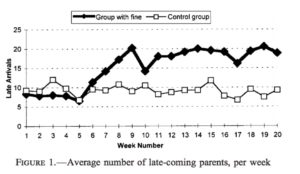An estimation error, client communication gone wrong, or a promise you didn’t fulfil? Despite your efforts to deliver exceptional services, products and effective contact, you’ll eventually find yourself responding to complaints. Exactly how do you tackle them? Rule one: You don’t handle complaints with financial compensation. Ever. I’ll explain why and how to bend complaints to your advantage.
But first: what exactly do we mean by financial compensation? It’s a sum of money with which you respond to the ‘psychological’ damage caused by an error. Are clients demanding this sort of compensation? Then they’re usually asking for more than the damage actually suffered.
What isn’t financial compensation? It is not damage compensation, because that actually does cover the exact amount of damage actually suffered. For example: your internet refuses to work for a day, so your provider takes one-thirtieth off the total of your invoice for the month.
Now, do you offer your clients financial compensation after a complaint? Because if you do, you’re encouraging a certain type of client relationship— a transactional. And risk falling into the commodity trap.
Build an emotional relationship with your client
We differentiate between two sorts of client relationships: transactional and emotional.
- In a transactional relationship, the entire focus is on the transaction—the sale. In this context, discounts, financial allowances and compensations work perfectly. At least, until the competition comes along with an even better price … What then? Do you give an even better discount? Lower your prices even further? Before you know it, you’ve landed with both feet in the commodity trap. Because there can only ever be one that’s the cheapest …
- Would you like to avoid this? Build an emotional relationship with your client. You do this by offering your client the total experience. And to understand what the total experience is, we suggest taking a look at Starbucks. They’re not exactly the cheapest place to go for your coffee. But we still go there in droves. Why? Starbucks works on offering their clients the complete experience. From the personal touches to the total atmosphere of the shop itself. You don’t just trade this experience in for a cheap cup of coffee.
Your client’s perception changes in the blink of an eye
Imagine your client has an emotional connection with your company. What happens when something goes wrong? Would compensation strengthen this relationship? Or would you run the risk of transforming the emotional relationship into a transactional one? How quickly would this happen?
Take a look at the following research into childcare centres. Children are often picked up late. It’s a fact that they used as the basis of an experiment in Israel:
- The idea? Ask parents to pay a fine when they’re ten minutes late.
- The goal? To make sure that fewer children are picked up late.
- The result? More parents arrived late. A lot more in fact. And worse yet: the fines were abandoned after three weeks but the parents continued to arrive late.[1]
What happened here? Two things:
- By executing a financial transaction, the client’s perception of the relationship changed. And that happened almost instantly. Parents saw the relationship as ‘transactional’.
- This perception remained even after the fine disappeared. The damage was done.
What do we want to show through this example? Perception can change very quickly from emotional to transactional. It’s then very difficult to turn the tide. There’s a great chance that you’ll head straight into the commodity trap.
How to escape the commodity trap
Once a transactional relationship with your clients, always a transactional relationship? Fortunately, that’s is not the case. No one is doomed to be or remain a commodity forever. At least, not if you differentiate yourself from the competition in a positive way.
When something goes wrong and results in a bevy of complaints, don’t play the compensation card. Because a complaint is an excellent opportunity to set yourself apart from the competition.
After the correct handling of a complaint, a client will be more satisfied than they were prior to the issue that resulted in the complaint. This may look like a contradiction—which is why this phenomenon is called the service recovery paradox. But everything has to do with the perception that remains in the memory.
Focus first on the person, then on the complaint
What does the ‘correct’ handling of complaints actually mean? Keep the steps of the following process in the back of your mind:
1. Take care of the person first …
Your client calls and is angry or disappointed … It’s our natural reflex to want to solve the problem immediately. We prefer to ignore the emotion involved. After all, what should we do with it? However, it’s in this lack of attention for emotion that the problem lies. Because it’s the emotion that determines how a client feels after the handling of the complaint.
Respond to the emotion first. Let your client know that you understand they’re frustrated. A simple “That sucks” can be enough. A client will only be ready to discuss possible solutions after they feel like they—and their emotions—have been acknowledged.
2. … and then solve the problem
Satisfaction depends more on the effort and creativity you show when solving the problem than it does on the problem itself.[2] This is in contradiction to what we often do: think of the ultimate solution and then propose it to the client. What happens if they’re not satisfied with that? We’re stuck there with nothing to say. And the client ends up feeling that we haven’t put in enough effort.
What are you better off doing? Brainstorming out loud. Think together about what possible options are. A client who appreciates your efforts to solve the problem is a happy client.
Don’t cross the bridge with money
Does financial compensation belong on this list of possible options? In the short term, it may appear to be a good way to calm the situation down. But in the long term, you’ll benefit by focusing on different ways of responding to complaints. Set yourself the goal of strengthening your emotional relationship the client. And keep following this time-honoured adage: money doesn’t make you happy.
Read more about how to deal with angry customers
[1]Gneezy, U., & Rustichini, A. (2000). A fine is a price. Journal of legal studies,vol. XXIX, http://rady.ucsd.edu/faculty/directory/gneezy/pub/docs/fine.pdf.
[2]Marinovan, D., Singh, S. & Singh, J. (2018), Frontline Problem-Solving Effectiveness: A dynamic analysis of verbal and nonverbal cues. Journal of marketing research.


